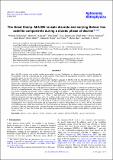Files in this item
The Great Slump : Mrk 926 reveals discrete and varying Balmer line satellite components during a drastic phase of decline
Item metadata
| dc.contributor.author | Kollatschny, Wolfram | |
| dc.contributor.author | Ochmann, Martin W. | |
| dc.contributor.author | Kaspi, Shai | |
| dc.contributor.author | Schumacher, Claas | |
| dc.contributor.author | Behar, Ehud | |
| dc.contributor.author | Chelouche, Doron | |
| dc.contributor.author | Horne, Keith | |
| dc.contributor.author | Müller, Björn | |
| dc.contributor.author | Rafter, Stephen E. | |
| dc.contributor.author | Chini, Rolf | |
| dc.contributor.author | Haas, Martin | |
| dc.contributor.author | Probst, Malte A. | |
| dc.date.accessioned | 2022-02-09T16:30:10Z | |
| dc.date.available | 2022-02-09T16:30:10Z | |
| dc.date.issued | 2022-01-31 | |
| dc.identifier | 277788457 | |
| dc.identifier | 89c5d4d6-1b6b-4460-ae43-372b825c75a3 | |
| dc.identifier | 85123617185 | |
| dc.identifier | 000745207600010 | |
| dc.identifier.citation | Kollatschny , W , Ochmann , M W , Kaspi , S , Schumacher , C , Behar , E , Chelouche , D , Horne , K , Müller , B , Rafter , S E , Chini , R , Haas , M & Probst , M A 2022 , ' The Great Slump : Mrk 926 reveals discrete and varying Balmer line satellite components during a drastic phase of decline ' , Astronomy & Astrophysics , vol. 657 , A122 . https://doi.org/10.1051/0004-6361/202142007 | en |
| dc.identifier.issn | 0004-6361 | |
| dc.identifier.other | RIS: urn:2C1D52A652D8E602D5387B582550F3D3 | |
| dc.identifier.other | RIS: 10.105100046361202142007 | |
| dc.identifier.uri | https://hdl.handle.net/10023/24840 | |
| dc.description | This work has been supported by the DFG grants KO857/35-1 and CH71/34-3. K. H. acknowledges support from STFC grant ST/M001296/1. D. C. acknowledges support from ISF grant 2398/19. | en |
| dc.description.abstract | Aims. Mrk 926 is known to be a highly variable active galactic nucleus. Furthermore, it is known to show very broad line profiles. We intended to study the continuum and line profile variations of this object with high temporal resolution in order to determine its broad-line region structure and to derive its black hole mass. Methods. We carried out a high-cadence spectroscopic variability campaign of Mrk 926 with the 10m HET telescope, aided by photometric V-band data taken with the C18 telescope at the Wise Observatory, over a period of about five months. We extracted spectroscopic continuum and line light curves, and computed cross-correlation functions (CCFs) as well as velocity-resolved CCFs with respect to the combined spectroscopic and photometric V-band light curve. Results. The continuum luminosity of Mrk 926 showed a drastic decrease during our campaign. The luminosity dropped to less than 50% of its original luminosity within only 2.5 months. Furthermore, the spectra of Mrk 926 show complex and very broad Balmer line profiles, including outer Balmer satellites ranging from ±5000 to ±13 000 km s−1. The integrated Hα, Hβ, and He Iλ5876 line light curves are delayed relative to the continuum light curve. The Hα and Hβ lines show two velocity-delay structures in the central part of their line profile (within ±5000 km s−1), at ∼10 and ∼57 light-days and at ∼5 and ∼48 light-days, respectively. These structures might be interpreted as the upper and lower halves of an ellipse in the velocity-delay plane, which might be the signature of a line-emitting ring, inclined by ∼50° to the line of sight and orbiting the black hole at radii, R, of 33.5 and 26.5 light-days. We determined continuum luminosities, log(λ Lλ/erg s−1), of 43.68–44.13, which are in good agreement with the established RBLR − LAGN relation. Adopting delays of 33.5 and 26.5 days for Hα and Hβ, respectively, we derive a black hole mass of (1.1 ± 0.2)×108 M⊙; this indicates a low Eddington ratio, which decreased from 8 to 3 percent during our campaign. The Balmer satellite components show a higher correlation coefficient with respect to the continuum than the central line profile, and their response to the continuum variations is on the order of only 3 − 5 days. We attribute this to the central line segment and the Balmer satellites having different, spatially distinct regions of origin. | |
| dc.format.extent | 23 | |
| dc.format.extent | 1582206 | |
| dc.language.iso | eng | |
| dc.relation.ispartof | Astronomy & Astrophysics | en |
| dc.subject | Galaxies: active | en |
| dc.subject | Galaxies: Seyfert | en |
| dc.subject | Galaxies: nuclei | en |
| dc.subject | Galaxies: individual: Mrk926 | en |
| dc.subject | Quasars: emission lines | en |
| dc.subject | QB Astronomy | en |
| dc.subject | QC Physics | en |
| dc.subject | NDAS | en |
| dc.subject | MCC | en |
| dc.subject.lcc | QB | en |
| dc.subject.lcc | QC | en |
| dc.title | The Great Slump : Mrk 926 reveals discrete and varying Balmer line satellite components during a drastic phase of decline | en |
| dc.type | Journal article | en |
| dc.contributor.sponsor | Science & Technology Facilities Council | en |
| dc.contributor.institution | University of St Andrews. School of Physics and Astronomy | en |
| dc.contributor.institution | University of St Andrews. St Andrews Centre for Exoplanet Science | en |
| dc.identifier.doi | https://doi.org/10.1051/0004-6361/202142007 | |
| dc.description.status | Peer reviewed | en |
| dc.identifier.url | https://arxiv.org/abs/2110.10051 | en |
| dc.identifier.grantnumber | ST/M001296/1 | en |
This item appears in the following Collection(s)
Items in the St Andrews Research Repository are protected by copyright, with all rights reserved, unless otherwise indicated.

